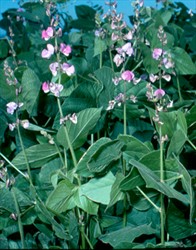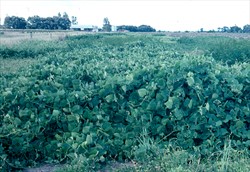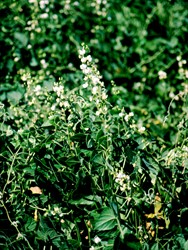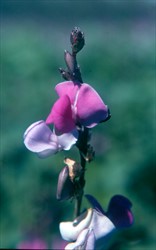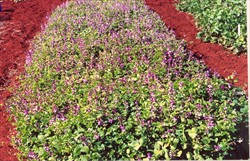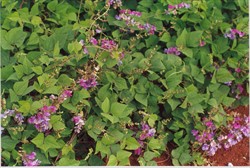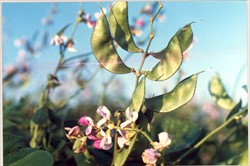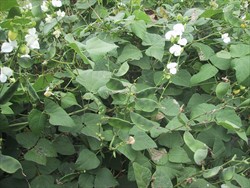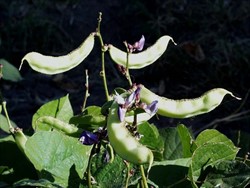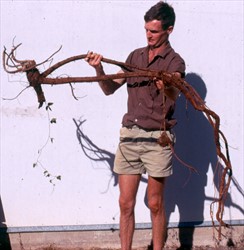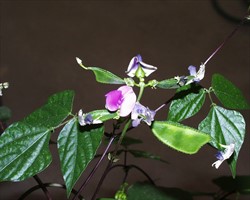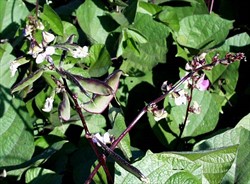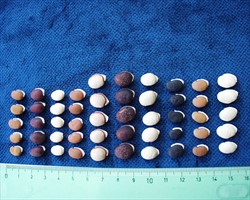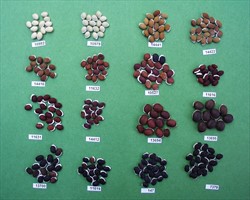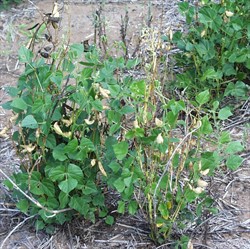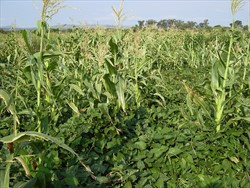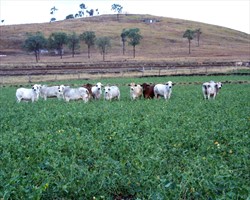Lablab purpureus
Tropical Forages
Lablab purpureus (L.) Sweet
Subordinate taxa:
Lablab purpureus (L.) Sweet subsp. bengalensis (Jacq.) Verdc.
Lablab purpureus (L.) Sweet subsp. purpureus
Lablab purpureus (L.) Sweet subsp. uncinatus Verdc.
subsp. bengalensis: Basionym: Dolichos bengalensis Jacq.
subsp. purpureus: Basionym: Dolichos purpureus L.; Dolichos lablab L.; Lablab leucocarpos Savi; Lablab niger Medik.; Lablab vulgaris Savi
Family: Fabaceae (alt. Leguminosae) subfamily: Faboideae tribe: Phaseoleae subtribe: Phaseolinae.
A bushy, trailing or twining herbaceous annual, biennial or perennial. Domesticated types are mostly summer growing annuals or occasionally short-lived perennials. Wild germplasm is strongly perennial. Stems robust, trailing to upright to 3‒6 m in length; basal stem of perennials may reach up to 4 cm diameter. Leaves trifoliolate; leaflets broad ovate-rhomboid, 7.5‒15 cm long, 1.5‒14 cm wide, acute at apex, almost smooth above and short haired underneath; petioles long and slender. Inflorescence a lax, fascicled, many-flowered axillary raceme 4‒ 20 cm long on peduncle 2‒40 cm long. Flowers white, blue or purple, on short pedicels; standard almost orbicular, 1.2‒1.6 cm diameter; keel bent in a right angle. Pods flat or inflated, 5‒20 cm × 1‒5 cm, straight or curved, usually with 3‒6 ovoid seeds of varying colour and size. Pods of cultivated types 4‒5 cm long, broadly scimitar-shaped, smooth and beaked by the persistent style, containing 2‒4 seeds, or 6‒8 in var. bengalensis. Seed ovoid, laterally compressed, 0.5‒1.2 cm long, 0.3‒0.9 cm wide, and 0.2‒0.7 cm thick, white or cream through to light and dark brown, red to black, sometimes mottled; conspicuous hilum, linear white aril extending around ⅓ of seed circumference. Seed of all wild material mottled. 2,000‒6,000 seeds per kg.
ssp. purpureus: pods scimitar-shaped, 4‒10 cm long, 2‒4 cm wide, with 2‒5 seeds.
ssp. bengalensis: pods linear-oblong to oblong, falcate, 3.5‒14 cm long, 1.2‒4 cm wide.
ssp. uncinatus: pods scimitar-shaped, about 4 cm long, 1.5 cm wide.
Africa: amora-guaya (Amharic); lablab, lupp (Arabic); guangono abrua (Côte d'Ivoire); njahi (Kenya); wáákén dànfámíí (Nigeria); mfiwi, mafuta (Swahili); agni guango ahura, o-cala, gerenga, fiwi bean, kikuyu bean, kashrengeig, lubia
Asia: 扁豆 bian dou, peng pi dou (China); kerara (Indonesia); mak thoua peb (Laos); kachang kara, kara-kara, kekara (Malaysia); pe gyi (Myanmar); batao, batau, bataw, beglau, parda, agaya, itab (Philippines); thua nang (Thai); dall van, đậu van, đậu móng chim (Vietnam)
Caribbean: bunabis, bannabees, saeme (West Indies); bonavis bean, seeim bean (Trinidad)
English: Australian pea (South America), bonavist bean, bonavista pea, field bean, hyacinth bean, lablab bean, pig-ears, poor man's bean, rongai dolichos, Tonga bean
Europe: antaque (Réunion), dolique d'Egypte, dolique lab-lab, pois boucoussou, pois bourcoussou (Antilles), pois nourrice (French); Laselbohne, Helmbohne, Lablabbohne (German); dolico egiziano, fagiolo d´egitto, fagiolo del cairo, fagiolo egiziano (Italian); haricot cutilinho, dólico do Egipto, feijão cutelinho (Portuguese); frijol de Egipto, frijol jacinto, quiquaqua, caroata chwata, poroto de Egipto, chicarros, frijol caballo, gallinita, frijol de adorno, carmelita (Spanish)
Indian subcontinent: Avare, ballar, chapparadavare, chikkadikai chikkuda, mochai numulu, mochakotta sem, pavta, shim, sin bean, val, wal; urahi, urchi, uri (Assamese); rajashimbi (Bengali); bhatvas, shimi, सेम sem (Hindi); capparada-avare, avare, avare baele (Kannada); amara, avara (Malayalam); হৱাঈ উৰী hawai uri (Manipuri); anvare, kadavebaala, pandhre pavate (Marathi); राज सिमी raaj simi (Nepali); nispavah (Sanskrit); ho-dhambala, hodhambala, kiri-dambala, kos-ata-dambala, ratu-peti-dambala (Sinhalese); அவரை avarai, motchai (Tamil); chikkudu, adavichikkudu, alsanda (Telugu)
Latin America: cumandá, cumandá açú, cumandatiá, dólicos ervilha, japonesa, fava da India, fava lablab, feijoeiro bravo, guar, labelabe, labe-labe, lablab, lab-lab, mangalo (Brazil); arbejón, arroz con coco, cabellero, chaucha japonesa, chicarros, chicharo, chimbolo verde, chivata, cícero, dolichos, dolichos rongai, dolico gigante, dolicos, fríjol caballero, frijol caballo, fríjol de adorno, fríjol de enredadera, frijol de tierra. fríjol Jacinto, fríjol punzada, fríjol trepador, frisol tropical, gallinazo blanco, gallinazo morado, gallinita, garbanzo indio, guaracaro, indianela, indianella, judía do Egipto, lablab, lubía, mulato, poroto de Egipto, poroto japonés, tapirusco (Spanish)
Pacific: chuchumeko (Chamorro); ndralawa (Fiji); pini'ae puaka (Tonga)
Note: Lablab is widely used as a pulse and vegetable (its use as a forage is fairly restricted) and has numerous common/vernacular names of which the above-listed are just some. The common names almost invariably refer to its use as a crop.
Native:
The most recent research points to lablab being a native to eastern and southern Africa where it was domesticated and subsequently dispersed across Africa and Asia (pre 2000 BC).
Cultivated:
Now widely cultivated as a crop pan-tropically, and especially important in India (especially southern India) and Bangladesh.
Forage
An annual forage crop in broad-acre agricultural systems in tropical environments with a summer rainfall and occasionally used for forage in cut-and-carry systems.
Environment
Lablab can be incorporated into cereal cropping systems as a legume ley to address soil fertility decline. It is also used as an intercrop species with maize to enable cereals and pulses to be grown simultaneously on the same land, usually in smallholder systems, and to achieve better legume/stover feed quality.
Other
Lablab is a major pulse crop in southern India and an important vegetable elsewhere especially in Bangladesh, where the green pods are widely used like snow peas. It is a minor pulse crop across Asia and Africa especially in Kenya and Tanzania.
Soil requirements
Grows in a wide range of soils from deep sands to heavy clays, provided drainage is good, and from pH 4.5 to 7.5. Low salinity tolerance with symptoms being chlorotic leaves, reduced growth and plant death.
Moisture
Adapted to annual rainfall regimes of 650‒3,000 mm. Drought tolerant when established, and will grow where rainfall is <500 mm, but loses leaves during prolonged dry periods. Capable of extracting soil water from at least 2 metres depth even in heavy textured soils. Will tolerate short periods of flooding but intolerant of poor drainage and prolonged inundation.
Temperature
Grows best at average daily temperatures of 18‒30 °C and is tolerant of high temperatures. Able to grow at low temperatures (down to 3 °C) for short periods. Frost susceptible, but tolerates very light frosts. More tolerant of cold than either Mucuna pruriens or cowpea (Vigna unguiculata). Will grow at altitudes from sea level to elevations of up to 2,000 m asl in tropical environments.
Light
Grows best in full light; intolerant of moderate to heavy shading.
Reproductive development
Short-day flowering response, with early ('Highworth') and late ('Rongai', 'Endurance') flowering types available. Other varieties are much earlier flowering than 'Highworth' with some crop landraces flowering as early as 55 days after sowing. Known to have some outcrossing but observations suggest that this is usually minimal. Being an annual or weak perennial, lablab flowers and sets seed in the first season of growth.
Defoliation
Three harvests possible from annual types, but will not stand heavy grazing of stems. For green manure, the crop should be cut before flower initiation. More tolerant of grazing than cowpea, and more harvests possible. As a forage, the crop should be utilised before flowering.
Fire
Intolerant of fire.
Guidelines for establishment and management of sown forages.
Establishment
Percentage of hard seed is very low and no scarification is required. Complete cultivation is used for lablab monocultures with seeding rates of between 12 and 20 kg/ha. Rows should be 80‒120 cm apart, with 30‒50 cm between plants. Seed can be planted to a depth of 3‒10 cm. Will establish readily when sown into subsurface moisture to a depth of at least 7‒10 cm. When planted with grasses, seed rates should be 5‒8 kg/ha. Will not establish readily into existing pastures without some form of soil disturbance. Provided seed is of good quality, germination should be rapid and uniform as commercial cultivars have soft seed and require no scarification. Lablab does not always nodulate well with native strains of rhizobia but some virgin soils in sub-tropical Australia appear to have suitable native rhizobia populations, which have resulted in good growth without inoculation of seed. Nevertheless it is recommended to be sown with the appropriate lablab rhizobia strain which in Australia is Group J (CB 1024).
Fertilizer
While it is common to grow lablab without fertilizer applications, sowings in sandy soils often require applications of phosphorus and sulphur and benefit from applications of lime in very acid soils.
Compatibility (with other species)
When used for forage in large areas, lablab is often sown with annual grass crops such as annual sorghums and millets. Such mixtures can be strip-grazed through late summer into autumn. Light grazing to remove leaf only will prolong the productive life of lablab forages. In smallholder systems, lablab can be intercropped with maize. The lablab should be sown about 28 days after the maize to avoid severe cereal crop yield depression from competition.
Companion species
Grasses: Annual forage sorghum (Sorghum spp.) and millets (Cenchrus americanus), summer cereal crops, maize (Zea mays) and sorghum (S. bicolor). Oversown into Megathyrsus maximus pastures in Brazil.
Pests and diseases
The pod -boring insect Adisura atkinsoni can reduce seed yields but has been controlled experimentally by strain HB-III of Bacterium cereus var. thuringensis. Other insect pests include Heliothis armigera, Exelastis atomosa and Maruca testulalis. Bruchid beetles (Callosobruchus spp.) damage seed during growth and storage.
Lablab roots are attacked by several nematodes: Helicotylenchus dihystera, Meloidogyne hapla and M. incognita.
Anthracnose (caused by Colletotrichum lindemuthianum), leaf-spot (caused by Cercospora dolichi) and powdery mildew (caused by Leveillula taurica var. macrospora) have been reported. A stem rot caused by Sclerotinia sclerotiorum may attack the plant under wet conditions. In Australia, cultivar Rongai is fairly disease-free and generally lablab is more tolerant of root diseases than cowpeas.
Ability to spread
Will not spread naturally under grazing. May volunteer in subsequent crops but this is usually only for one year because of the low level of hard seed.
Weed potential
None due to its short-lived nature and poor longevity of seed. Reported as a weed in cropped areas in some humid-tropical locations where individual plants may live up to 3 years, but no report as an environmental weed.
Nutritive value
Leaf has CP content of 21‒38%, commonly about 26%. Much lower for stem (7‒20%). Grain contains 20‒28% CP. Digestibility ranges from 55 to 76%, commonly >60% (leaves). Grain high in vitamins A, B and C.
Palatability/acceptability
Leaf is highly palatable, but stem has low palatability. Palatability of grain is low to moderate depending on variety.
Toxicity
Leaf does not contain anti-nutritive factors such as tannins. Mixed plantings with forage sorghum prevents the occurrence of bloat. Grain contains tannins, and phytate and trypsin inhibitors. Concentrations vary among varieties. Soaking or cooking reduces the activity of these compounds.
Feedipedia link
Dry matter
Seasonal yields of 2 t/ha leaf or 4 t/ha stem and leaf are common in sub-humid sub-tropics but yields can often exceed 6‒7 t/ha. Dry matter yield is usually higher than for cowpea, particularly under drier conditions. For human nutrition, 2-7 t/ha green pods. In monoculture, 1‒2.5 t/ha DM (grain) depending on cultivar is achieved.
Animal production
In Brazil, Zebu cattle grazing maize stalks, dry grasses and green lablab gained 350 g/head/day over a 3-month period, while cattle without lablab lost weight. In sub-tropical Australia, cattle gains have ranged from 0.09 to 1.04 kg/head/day depending on the feeding conditions. Trials in Zimbabwe have demonstrated that the use of a lablab hay supplement resulted in milk yield increases slightly less than those obtained through the use of velvet bean (Mucuna pruriens). Milk quality was also slightly less than that achieved with velvet bean but still very acceptable. Supplementing the diet of goats with lablab in Zimbabwe has been shown to yield better condition for does, higher kid birth weights and growth rates, and higher milk yields.
Lablab was previously included in the genus Dolichos following Linneus, but is now assigned to its own monotypic genus. Three subspecies are recognized in L. purpureus; ssp. uncinatus, the wild ancestral form distributed mainly in East Africa with small, scimitar-shaped pods; ssp. purpureus, with larger, scimitar-shaped pods, cultivated as a pulse crop and including commercial forage varieties; and ssp. bengalensis, which has large linear-oblong shaped pods, widespread in S Asia and used as both a pulse and a forage. Although pod shape is a significant morphological difference, it is now the view that ssp. bengalensis and ssp. purpureus are genetically very similar. Although most domesticated material is either ssp. purpureus or ssp. bengalensis, ssp. uncinatus has been domesticated in Ethiopia. Studies in lablab have shown that the perennial (wild) types have considerable genetic and morphological diversity. Hybrids between perennial and forage types have been produced at CSIRO, Australia and have resulted in new cultivars being released (cv. Endurance). Lablab is predominantly self-fertilizing. Chromosome number 2n = 22.
Intermittent flowering and pod production in the forage types. Grain maturation on the forage cultivars is not uniform but crop landrace types have more synchronous maturity. High grain yields of 1‒2.5 t/ha of forage types, depending on cultivar, but when grown on trellises in smallholder systems the grain yields can be far greater. In mixtures with other crops, grain yields 0.5 t/ha. Late seeding varieties (e.g. cv Rongai) may be affected by early frosts.
There is some evidence that lablab accessions with light (cream or white) coloured seeds have poor storage potential, which in turn affects seedling vigour and establishment.
Lablab is highly sensitive to 2,4-D, M.C.P.A., 2,4-D-B and dicamba.
- A dual purpose legume and can be used with cereals in smallholder systems.
- Can be sown with summer grass crops to provide a mixed forage crop system.
- High forage quality.
- As a green manure crop restores soil fertility.
- Drought tolerant once established.
- High grain yields.
- Better root disease resistance than cowpeas.
- Poor frost tolerance.
- Intolerant of poor drainage.
- Susceptible to a range of insect pest.s
- Indeterminate flowering leading to extended seeding period in current cultivars.
Agishi, E.C. (1991) A bibliography on Lablab purpureus . Plant Science Division Working Document No. A6 . International Livestock Centre for Africa (ILCA), Addis Ababa, Ethiopia.
Ayisi, K.K., Bopane, M.P. and Pengelly, B.C. (2004) Assessment of the variation in growth and yield of diverse lablab (Lablab purpureus ) germplasm in Limpopo Province, South Africa. In: Whitbread, A.M. and Pengelly, B.C. (eds). Tropical Legumes for Sustainable Farming Systems in Southern Africa and Australia. ACIAR proceedings No. 115. pp. 44-50.
Bell, L.W., Lawrence, J., Johnson, B. and Whitbread, A.M. (2012) Exploring short-term ley legumes in subtropical grain systems: production, water-use, water-use efficiency and economics of tropical and temperate options. Crop and Pasture Science, 63, 819-832.
Cameron, D.G. (1988) Tropical and subtropical pasture legumes. Queensland Agricultural Journal, March-April, 110-113.
English, B.H. (1999) Lablab purpureus in Australia. In: Loch, D.S. and Ferguson, J.E. (eds). Forage seed production. Vol. 2: Tropical and subtropical species. pp. 395-399. (CAB International, Wallingford, UK).
Hendricksen, R.E. and Minson, D.J. (1985) Lablab purpureus - a review. Herbage Abstracts, 55, 215-228.
Hill, J.O., Robertson, M.J., Pengelly, B.C., Whitbread, A.M. and Hall, C.A. (2006) Simulation modelling of lablab (Lablab purpureus) pastures in northern Australia. Australian Journal of Agricultural Research, 57, 389-401.
Loch, D.S. and Ferguson, J.E. (1999) Tropical and subtropical forage seed production: an overview. In: Loch, D.S. and Ferguson, J.E. (eds). Forage seed production. Vol. 2: Tropical and subtropical species. pp. 1-40. (CAB International, Wallingford, UK).
Maass B.L. ( 2016) Domestication, origin and global dispersal of Lablab purpureus (L.) Sweet (Fabaceae): current understanding. Legume Perspectives,13, 5-8.
Agishi, E.C. (1991) A bibliography on Lablab purpureus. Plant Science Division Working Document No. A6. International Livestock Centre for Africa (ILCA), Addis Ababa, Ethiopia.
Ayisi, K.K., Bopane, M.P. and Pengelly, B.C. (2004) Assessment of the variation in growth and yield of diverse lablab (Lablab purpureus ) germplasm in Limpopo Province, South Africa. In: Whitbread, A.M. and Pengelly, B.C. (eds) Tropical Legumes for Sustainable Farming Systems in Southern Africa and Australia. ACIAR Proceedings No. 115. Australian Centre for International Agricultural Research (ACIAR), Canberra, Australia. p. 44–50. aciar.gov.au/node/8436
Bell, L.W., Lawrence, J., Johnson, B. and Whitbread, A.M. (2012) Exploring short-term ley legumes in subtropical grain systems: production, water-use, water-use efficiency and economics of tropical and temperate options. Crop and Pasture Science 63:819–832. doi.org/10.1071/CP12190
Cameron, D.G. (1988) Tropical and subtropical pasture legumes. Queensland Agricultural Journal 114: 110–113.
English, B.H. (1999) Lablab purpureus in Australia. In: Loch, D.S. and Ferguson, J.E. (eds) Forage seed production, Volume 2: Tropical and subtropical species. CABI Publishing, Wallingford, Oxon, UK. p. 395–399.
Hendricksen, R.E. and Minson, D.J. (1985) Lablab purpureus - a review. Herbage Abstracts 55:215–228.
Hill, J.O., Robertson, M.J., Pengelly, B.C., Whitbread, A.M. and Hall, C.A. (2006) Simulation modelling of lablab (Lablab purpureus) pastures in northern Australia. Australian Journal of Agricultural Research 57:389–401. doi.org/10.1071/AR05263
Loch, D.S. and Ferguson, J.E. (1999) Tropical and subtropical forage seed production: an overview. In: Loch, D.S. and Ferguson, J.E. (eds) Forage seed production, Volume 2: Tropical and subtropical species. CABI Publishing, Wallingford, Oxon, UK. p. 1–40.
Maass B.L. (2016) Domestication, origin and global dispersal of Lablab purpureus (L.) Sweet (Fabaceae): current understanding. Legume Perspectives 13:5–8. bit.ly/2UMGucP
Maass, B.L., Jamnadass, R.H., Hanson, J. and Pengelly, B.C. (2005) Determining sources of diversity in cultivated and wild Lablab purpureus related to provenance of germplasm by using amplified fragment length polymorphism. Genetic Resources and Crop Evolution 52:683–695. doi.org/10.1007/s10722-003-6019-3
Maass, B.L., Knox, M.R., Venkatesha, S.C., Tefera, A.T., Ramme, S. and Pengelly, B.C. (2010) Lablab purpureus - A crop lost for Africa? Tropical Plant Biology 3:123–135. doi.org/10.1007/s12042-010-9046-1
Murphy, A.M. and Colucci, P.E. (1999) A tropical forage solution to poor quality ruminant diets: a review of Lablab purpureus. Livestock Research for Rural Development 11:21. lrrd.org/lrrd11/2/colu112.htm
Murungweni, C., Mabuku, O. and Manyawu, G.J. (2004) Mucuna, lablab and paprika calyx as substitutes for commercial protein sources used in dairy and pen-fattening diets by smallholder farmers in Zimbabwe. In: Whitbread, A.M. and Pengelly, B.C. (eds) Tropical legumes for sustainable farming systems in southern Africa and Australia. ACIAR Proceedings No. 115. Australian Centre for International Agricultural Research (ACIAR), Canberra, Australia. p. 126–135. aciar.gov.au/node/8436
NAS (1979) Lablab bean. In: Tropical legumes: Resources for the future. National Academy of Sciences (NAS), Washington, DC., USA. p. 59–67. doi.org/10.17226/19836
Oram, R.N. (1990) Register of Australian Herbage Plant Cultivars, Third Edition. CSIRO, Melbourne, Australia. p. 173–174. hdl.handle.net/102.100.100/256559
Pengelly, B.C. and Maass, B.L. (2001) Lablab purpureus (L.) Sweet - diversity, potential use and determination of a core collection of this multi-purpose tropical legume. Genetic Resources and Crop Evolution 48:261–272. doi.org/10.1023/A:1011286111384
Peters, M., Franco, L.H., Schmidt, A. and Hincapié, B. (2003) Especies forrajeras multipropósito: Opciones para productores de Centroamerica. Centro Internacional de Agricultura Tropical (CIAT), Cali, Colombia. hdl.handle.net/10568/54681
Schaaffhausen, R. von. (1963) Dolichos lablab or hyacinth bean: its uses for feed, food and soil improvement. Economic Botany 17:146–153. doi.org/10.1007/BF02985365
Shivashankar, G. and Kulkarni, R.S. (1989) Lablab purpureus (L.) Sweet. In: van der Maesen, L.J.G. and Somaatmadja, S. (eds) Plant Resources of South-East Asia No. 1. Pulses. Pudoc Scientific Publishers, Wageningen, the Netherlands. p. 48–50. edepot.wur.nl/281901
Smartt, J. (1985) Evolution of grain legumes. II. Old and new world pulses of lesser economic importance. Experimental Agriculture 21:1–18. doi.org/10.1017/S0014479700012205
Smith, G.R., Rouquette Jr., F.M. and Pemberton, I.J. (2008) Registration of ‘Rio Verde’ Lablab. Journal of Plant Registrations 2:15. doi.org/10.3198/jpr2007.03.0164crc
Whitbread, A.M., Ayisi, K., Odhiambo, J.J.O., Maluleke, N. and Pengelly, B.C. (2011) Evaluating Lablab purpureus (L.) Sweet germplasm to identify short-season accessions suitable for crop and livestock farming systems in southern Africa. African Journal of Range & Forage Science 28:21–28. doi.org/10.2989/10220119.2011.570950
Whitbread, A.M., Pengelly, B.C. and Smith, B.R. (2005) An evaluation of three tropical ley legumes for use in mixed farming systems on clay soils in southern in land Queensland, Australia. Tropical Grasslands 39:9–21. bit.ly/2UtHB2d
'Dash' A moderately early-flowering annual forage cultivar selected from a single plant from within a population of ILRI 14437. Introduced to ILRI from Zimbabwe via the forage collection of the National Agricultural Research Centre, Kitale, Kenya.
'ELDO-KT Maridadi' A late-maturing (> 5 months), stay-green cultivar developed by the University of Eldoret, for the Central & North Rift as well as Western regions of Kenya, released in 2015. The spotted seeds have a good flavour and short cooking time; the cultivar has high forage production. Seed is maintained at University of Eldoret, Eldoret, Kenya.
'Endurance' A weakly perennial cultivar, developed from the strongly perennial (wild) line CPI 24973 and cv. Rongai, and released as a cultivar in 1998. 'Endurance' grows well in the second and even into third year after grazing or cutting. High DM production potential. Seed weight 5,500 seeds/kg. 'Endurance' seed is no longer commercially available.
'Highworth' Introduced to Australia as CPI 30212 from southern India and released as a cultivar in Australia in 1973. Earlier-flowering variety originally intended for grain production (high seed yield) in areas experiencing early frosts. Also has adequate forage DM production. 'Highworth' has purple flowers and black seeds. Seed weight 4,000 seeds/kg.
'KAT/DL-3' An indeterminate, dual-purpose cultivar released by KARI-Katumani (Kenya Agricultural Research Institute, now KALRO: Kenya Agricultural & Livestock Research Organization) in Kenya in 1995. Seed is maintained at KALRO-Katumani, Machakos, Kenya.
'Koala' Erect, early maturing grain type, released as a cultivar in Australia in 1995. Wing petals of freshly opened flowers violet to purple with violet-blue venation; seed cream coloured. Able to seed set before the onset of frost in northern NSW and southern Queensland, Australia. Produces about 70% of the DM yield of 'Highworth' and 'Rongai'.
'Rio Verde' (Reg. No. CV-280, PI 648441) Developed at the Texas A&M AgriLife Research and Extension Center at Overton, Texas and released by Texas A&M AgriLife Research in 2006; it is the first lablab cultivar released in the USA. A vining, herbaceous tropical legume with high nutritive value as a forage or browse for ruminant animals. Qualities include drought tolerance, high palatability, high nutritive value, excellent forage yield and adaptation to diverse environmental conditions; tolerance to defoliation and Texas seed production. Seed weight is 7,000‒7,400 seeds/kg. (URL: https://aggieclover.tamu.edu/rio-verde/; https://dl.sciencesocieties.org/publications/jpr/abstracts/2/1/15/preview/pdf)
'Rongai' Introduced to Australia as CPI 17883 from Kenya and released as a cultivar in Australia in 1962. A late-flowering variety with high DM production. 'Rongai' has white flowers and light brown seeds. In the absence of frosts, may flower over several months. Most common forage cultivar. Seed weight 5,000 seeds/kg.
CPI 67639: This forage type accession has black seeds. It appears to have greater resistance to seed borers, possibly through thicker seed testa.
CQ 3632, CQ3633, P5305, P5310, Q6879: These Australian-registered accessions have similar agronomic attibutes to cvv. Highworth and Rongai.
CPI 29399, CPI 30701, CPI 52506B, CPI 81364: All of these accessions produced >5t/ha biomass in at 87 days after sowing on farmer's fields near Polokwane, Limpopo, South Africa.
Q 6880B: This is the most consistent yielding dual purpose accession under dryland and even drought conditions in northern Tanzania and semi-arid Kenya (short growing seasons). Farmers have been enthusiastic about its agronomic properties because of its early yield and that it remains green for extended periods. It also intercrops relatively well with maize. Unfortunatley the grain appears to be rather bitter and so this accession may be unacceptable in the market.
CPI 24973 (origin Zimbabwe), CPI 52437 (origin South Africa) and CPI 60216 (origin Uganda) are examples of vigorous perennial accessions.
